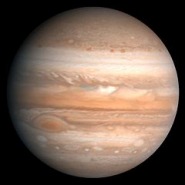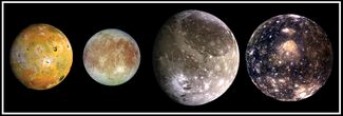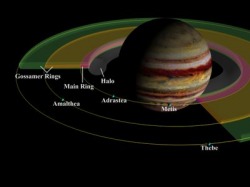Jupiter

Jupiter is the fifth planet from the Sun and the largest planet within the Solar System. It is two and a half times as massive as all of the other planets in our Solar System combined. Jupiter, along with Saturn, Uranus and Neptune, is classified as a gas giant. Together, these four planets are sometimes referred to as the Jovian planets, where Jovian is the adjectival form of Jupiter.
The planet was known by astronomers of ancient times and was associated with the mythology and religious beliefs of many cultures. The Romans named the planet after the Roman godJupiter.[10] When viewed from Earth, Jupiter can reach an apparent magnitude of −2.8, making it the third brightest object in the night sky after the Moon and Venus. (However, at certain points in its orbit, Mars can briefly exceed Jupiter's brightness.)
The planet Jupiter is primarily composed of hydrogen with a small proportion of helium; it may also have a rocky core of heavier elements under high pressure. Because of its rapid rotation, Jupiter's shape is that of an oblate spheroid (it possesses a slight but noticeable bulge around the equator). The outer atmosphere is visibly segregated into several bands at different latitudes, resulting in turbulence and storms along their interacting boundaries. A prominent result is the Great Red Spot, a giant storm that is known to have existed since at least the seventeenth century. Surrounding the planet is a faint planetary ring system and a powerful magnetosphere. There are also at least 63 moons, including the four large moons called the Galilean moons that were first discovered by Galileo Galilei in 1610. Ganymede, the largest of these moons, has a diameter greater than that of the planet Mercury.
Jupiter has been explored on several occasions by robotic spacecraft, most notably during the early Pioneer and Voyager flyby missions and later by the Galileo orbiter. The latest probe to visit Jupiter was the Pluto-bound New Horizons spacecraft in late February 2007. The probe used the gravity from Jupiter to increase its speed and adjust its trajectory toward Pluto, thereby saving years of travel. Future targets for exploration include the possible ice-covered liquid ocean on the Jovian moon Europa.
Moons of Jupiter

Although claims are made for the observation of one of Jupiter's moons by Chinese astronomer Gan De in 364 BC, the first certain observations of Jupiter's satellites are those of Galileo Galilei in 1610, who sighted the four large Galilean moons with his 33x telescope.
No additional satellites were discovered until E.E. Barnard observed Amalthea in 1892. Further discoveries, aided by telescopic photography, followed quickly over the course of the twentieth century, and by 1975, before the Voyagers reached Jupiter, the planet was known to have at least thirteen satellites.
The Voyager 1 mission discovered three inner moons in 1979, bringing the total then known to 16 (17 if one counted Themisto, which had been found but then lost in 1975). The total rested there until 1999. Since then, researchers using sensitive ground-based detectors have recovered Themisto and found a further 46 tiny moons in long, eccentric, generally retrograde orbits. They average 3 kilometres in diameter, and the largest is barely 9 km across. All of these moons are thought to be captured asteroidal or perhaps cometary bodies, possibly fragmented into several pieces, but very little is actually known about them. The total number of known moons of Jupiter now stands at 63, currently the most of any planet in the solar system. Many additional tiny moons may exist that have not yet been discovered.
On October 6, 1999, the Spacewatch project discovered an asteroid, 1999 UX18. But it was soon realised that this was in fact a previously undiscovered moon of Jupiter, now called Callirrhoe. One year later, between November 23 and December 5, 2000, the team led by Scott S. Sheppard and David C. Jewitt of the University of Hawaii began a systematic search for small irregular moons of Jupiter. The other members of the team included, at various times, Yanga R. Fernández, Eugene A. Magnier, Scott Dahm, Aaron Evans, Henry H. Hsieh, Karen J. Meech, John L. Tonry, David J. Tholen (all from the University of Hawaii), Jan Kleyna (Cambridge University), Brett J. Gladman (University of Toronto), John J. Kavelaars (Hertzberg Institute of Astrophysics), Jean-Marc Petit (Observatoire de Besançon) and Rhiannon Lynne Allen (University of Michigan / University of British Columbia).
The team used the world's two largest CCD cameras, mounted on two of the thirteen telescopes atop Mauna Kea in Hawaii: the Subaru (8.3 m diameter) and the Canada-France-Hawaii (3.6 m). The 2000 observations revealed ten new moons, putting the count at 28 (Themisto had been rediscovered at the beginning of 2000).
The following year, between December 9 and 11, 2001, eleven other moons were discovered, bringing the total to thirty-nine. The year 2002 bore less fruit, netting only one moon, Arche. However, four months later, between February 5 and 9, 2003, twenty-three more moons were found, making for a complete sum of sixty-three moons.
Rings of Jupiter

The planet Jupiter has a system of rings, known as the rings of Jupiter or the Jovian ring system. It was the third ring system to be discovered in the Solar System, after those of Saturn and Uranus. It was first observed in 1979 by the Voyager 1 space probe[1] and thoroughly investigated in the 1990s by the Galileo orbiter.[2] It has also been observed by the Hubble Space Telescope and from Earth for the past 25 years.[3] Ground-based observations of the rings require the largest available telescopes.[4]
The Jovian ring system is faint and consists mainly of dust.[1][5] It comprises four main components: a thick inner torus of particles known as the "halo ring"; a relatively bright, exceptionally thin "main ring"; and two wide, thick and faint outer "gossamer rings", named for the moons of whose material they are composed: Amalthea and Thebe.[6]
The main and halo rings consist of dust ejected from the moons Metis, Adrastea and other unobserved parent bodies as the result of high-velocity impacts.[2] High-resolution images obtained in February and March 2007 by the New Horizons spacecraft revealed a rich fine structure in the main ring.[7]
In visible and near-infrared light, the rings have a reddish color, except the halo ring, which is neutral or blue in color.[3] The size of the dust in the rings varies, but the cross-sectional area is greatest for nonspherical particles of radius about 15 μm in all rings except the halo.[8] The halo ring is probably dominated by submicron dust. The total mass of the ring system (including unresolved parent bodies) is poorly known, but is probably in the range of 1011 to 1016 kg.[9] The age of the ring system is not known, but it may have existed since the formation of Jupiter.[9]
